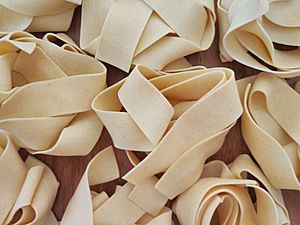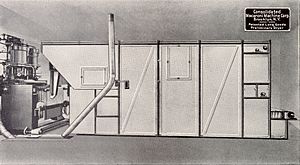Pasta processing facts for kids
Pasta processing is how we make pasta! It involves mixing semolina (a special kind of wheat flour) or other flours with water. This creates a dough that is then pushed into different shapes. After shaping, the pasta is dried and finally packaged.
To make pasta, durum wheat semolina or other flours are mixed with water. Sometimes, eggs are added for egg noodles. Other ingredients like spinach or tomato can also be included for flavor and color. About 25-30 kg of water is usually added for every 100 kg of semolina. Computers help measure these amounts precisely.
The mixture is then kneaded by a machine called an auger extruder. This machine has paddles and blades that mix everything until it's smooth. After mixing, the dough is pushed through special molds called dies to create different pasta shapes. Drying starts right away to stop the pasta from losing its shape or sticking together. Finally, the pasta is fully dried in special chambers and made stable, ready for packaging. Modern factories use automatic lines to make dry pasta.
Contents
Mixing Pasta Ingredients
Making pasta starts with mixing semolina and water. The usual ratio is about three parts semolina to one part water. The water needs to be clean and safe to drink. It's often warmed to about 35-45°C (95-113°F). This helps the semolina soak up the water faster.
If you're making egg noodles, eggs are added too. These can be fresh, frozen, or dried eggs, or even just egg yolks. When eggs are added, the amount of water is adjusted. Adding eggs makes the pasta more nutritious and richer. Sometimes, a special ingredient called disodium phosphate is added. This helps the pasta cook faster.
Mixing the semolina and water happens in two steps. First, the ingredients are measured and put into a pre-mixer. Then, they move to a final mixing chamber. This chamber finishes the mixing process, making a smooth, even dough.
Measuring Raw Materials
Getting the exact amount of ingredients is very important for good pasta. Semolina can be measured in two main ways: by volume or by weight.
Measuring by volume means a specific amount of semolina is taken. This is done using screws or valves that turn at different speeds. However, this method isn't super accurate. The amount can change depending on how dense the semolina is.
Measuring by weight is more precise. Semolina is weighed as it moves along a special transport system. This system has a device that measures the flow. This method is more accurate but also more expensive. It often needs its own separate area.
There are a few ways to measure the flow when weighing ingredients:
- Conveyor Belt Feeds: A part of the belt is weighed. The belt's speed helps calculate how much semolina is flowing.
- Loss-in-Weight Feeds: Semolina is poured from a container called a hopper. The change in the hopper's weight shows how much semolina has been used.
- Slanted Surface System: Electronic devices measure the movement of parts like screws. This movement is then turned into a measurement of semolina flow.
The right amount of water for the dough depends on the pasta's final shape. Long pastas, like spaghetti, need less moisture. This helps them stretch properly during shaping. Short pastas, like macaroni, also need less moisture because they are cut quickly. Different pumps are used to add water to the mixture. Common types include piston pumps, screw feeders, and gear pumps. More advanced systems use electronic devices to control the water flow precisely.
Pre-mixing Ingredients
The measured water and semolina are first mixed in a pre-mixer. This creates a crumbly dough. Older pre-mixers use a long, round container with a spinning shaft and blades inside. Newer systems use a high-speed (centrifuge) pre-mixer. In these, water and semolina are sprayed into a chamber. This makes sure each tiny piece of semolina gets the right amount of water.
Final Dough Mixing
The final mixer is a long container with shafts and mixing blades. Both the shafts and blades are made of stainless steel. The shafts spin slowly, around 70 rotations per minute (rpm). This mixes the ingredients into a smooth dough. This step usually takes about 10 to 20 minutes.
Some mixers work in normal air pressure. Others work under a vacuum, which means the air is removed. If a vacuum is used, the dough goes straight into the shaping machine. If the mixer works in normal air, a separate vacuum unit moves the dough to the shaping machine.
Shaping Pasta: Extrusion
Extrusion is a fast process where the dough is kneaded and shaped at the same time. This happens in a machine called an extruder. The extruder has a special cylinder with grooves inside. A shaft with a deep spiral thread, called an extrusion worm, is inside the cylinder.
The extrusion worm kneads the dough and pushes it forward. It then presses the dough through special molds, or dies, at the end of the extruder. The grooves in the cylinder help reduce rubbing and make the dough move better. Both the worm and the cylinder are made of stainless steel. The worm often has a Teflon coating. This coating helps reduce friction even more.
The dough's temperature should stay between 40-45°C (104-113°F). If it gets hotter than 50°C (122°F), the gluten in the dough can be damaged. This would make the pasta poor quality. Since the pressure and rubbing create heat, there are water jackets around the cylinder and head. A lot of water, moving quickly at 38-40°C (100-104°F), flows through these jackets to keep the temperature down.
The cylinder also has a vacuum chamber. This chamber removes air bubbles from the dough before it's shaped. If air bubbles stay in the pasta, they can make it weak. This could cause the pasta to break hours or days after drying. Air can also change the color of the pasta, making it look white or chalky.
Forming Pasta Shapes
There are many different types of dies to create various pasta shapes. Pasta is generally put into two main groups: long pasta and short pasta. Long pastas include spaghetti, fettuccine, and linguine. Short pastas include elbow-shaped macaroni, penne, and shells.
Circular dies with spinning blades underneath are used for short pasta shapes. Long, rectangular dies are used to make long pasta shapes. These dies are made of bronze and coated with Teflon. The extruder pushes the dough through the dies. Blades or trimmers then cut the dough to the right length. Many different machines have been invented to make all sorts of pasta shapes.
Drying Pasta
Drying is one of the most important and tricky parts of making pasta. If pasta dries too quickly, it might crack during or after the process. This can make it look bad and become weak. If it dries too slowly, it might spoil or get moldy. So, drying must be done very carefully to avoid these problems.
When pasta comes out of the shaping machine, it has about 31% moisture. The goal is to dry it to about 12% moisture. This makes the pasta firm and helps it last a long time in storage. The drying process is a bit different for long and short pastas. But generally, hot air is used to remove water from the pasta.
"Pre-drying" starts right after the pasta is shaped. In this stage, the outside of the pasta hardens, but the inside stays soft. This step takes about one-tenth of the total drying time. About one-third of the extra moisture is lost here. "Final drying" removes most of the remaining moisture. This gives the pasta its firm shape. This stage has two parts: first, the pasta is exposed to high heat and humidity. Then, the temperature quickly drops, and cold air is used for stabilizing. Stabilizing helps the remaining moisture spread evenly through the pasta. This prevents cracking.
Drying Long Pasta

For long pastas, a machine called a spreader hangs the strands on metal sticks. Heated air then blows on them to get them ready for high temperatures. The pre-dryer quickly reduces the moisture from 30% to about 18% in about an hour. Heat comes from hot water radiators and fans.
For the first part of the final drying, the pasta goes into a dryer with many rows of hot water plates. This step removes a lot of moisture and also pasteurizes the pasta. In the second part, warm air blows on the pasta in a special multi-tier dryer. This removes all the extra moisture.
Drying Short Pasta
Short pasta pieces fall onto a shaker conveyor. Powerful hot air is blown on them right after they are shaped. This reduces their moisture content by 5%. It also stops the pieces from sticking together or flattening. The shaker then moves the pasta through different levels with dry hot air. Buckets collect the pasta and spread it onto the top level of a multi-tier drying unit.
This drying unit has four areas. Periods of strong moisture removal happen, followed by periods of rest. This cycle repeats eight times in total for drying and stabilizing. The process finishes in a cold air chamber for final stabilizing.
Packaging Pasta
There are two main ways to package dried pasta. One way is using cellophane bags. These bags keep moisture out and work well with automatic machines. However, they can be hard to stack. The other way is using boxes. Boxes are easy to stack and good for printing advertisements. They also protect fragile pasta better.
In the packaging line, the pasta is first weighed. Then, it's sealed in the package. Machines check for open flaps or metal pieces. The weight is double-checked. Finally, the packages are put into larger cases.
Long pasta packaging: First, about five scales on the packaging line weigh the pasta. Then, it's moved into mechanical buckets. These buckets fit over the openings of the cartons. A system called a horizontal cartoner is used for long pasta. The buckets and cartons both move forward on the line. A mechanical device pushes the pasta from the bucket into the cartons. The cartons are then closed and sealed.
Short pasta packaging: The process for short pasta is similar to long pasta. However, a vertical cartoner is used. With this system, the weighing unit is above the cartoner. The weighed pasta simply drops into the passing cartons using gravity.
Flexible pouch packaging: Both long and short pasta can be packed in flexible plastic bags. This system is called a standard form/fill/seal system. It works similarly to carton packaging.
Plastic overwrapping packaging: The weighed pasta is placed by hand onto a shallow plastic tray. A plastic film is then wrapped around the tray and the package. It then goes through a heat tunnel. The heat makes the film shrink tightly around the pasta.



